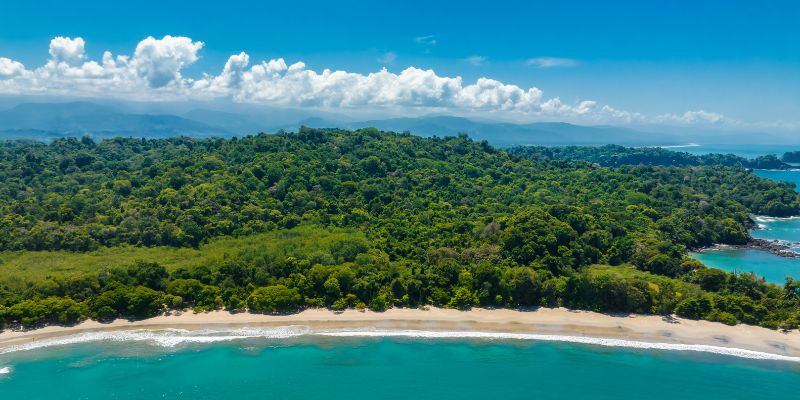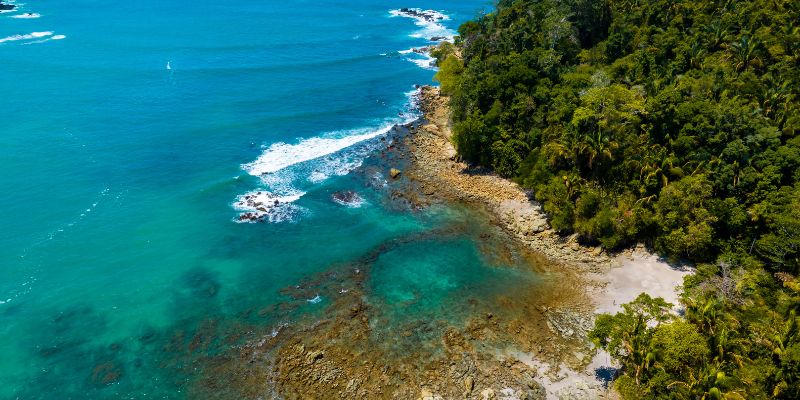These Facts About Costa Rica's Manuel Antonio National Park Will Shock You
Mar 05, 2024 By Juliana Daniel
Manuel Antonio National Park, a jewel in Costa Rica's crown, bursts with biodiversity and breathtaking beauty. Despite its relatively small dimensions, it has a powerful punch, offering an unforgettable experience for nature enthusiasts. Here are 5 fascinating facts that reveal the unique character of this park:
1. Tiny But Mighty: A Champion for Conservation
Don't be fooled by its size. Spanning a mere 16 square kilometers (roughly twice the size of Central Park in New York City!), Manuel Antonio holds the title of the smallest national park in Costa Rica. Yet, it's undeniably the most popular, drawing in over 150,000 visitors annually. This popularity necessitated a conservation measure a daily entry cap of 600 visitors on weekdays and 800 on weekends and holidays. This ensures the park's delicate ecosystem remains protected.
However, Manuel Antonio's significance goes beyond its popularity. It played a pivotal role in Costa Rica's conservation movement. In the 1960s, a group of concerned citizens, including local teachers and lawyers, rallied against a proposed development project that threatened the area's pristine beaches and rainforests. Their successful campaign led to the park's establishment in 1972, setting a precedent for community-driven conservation efforts in Costa Rica.
2. A Diverse Spot: Where Rainforests Meet Reefs
Manuel Antonio isn't just about stunning beaches. It's a mosaic of diverse habitats teeming with life. Lush rainforests, crisscrossed by well-maintained trails, provide a home for an incredible variety of plants and wildlife. Over 346 plant species find a home here, from towering tropical hardwoods to swaying palm trees and vibrant flowering plants.
But the magic extends beyond the forest floor. The park's borders reach into the Pacific Ocean, encompassing an additional 250 square kilometers of marine landscape. This includes 12 small islands and a network of coral reefs, transforming Manuel Antonio into a snorkeler's paradise. Here, vibrant fish dart amongst colorful coral formations while gentle giants like sea turtles glide through the crystal-clear waters.
This incredible biodiversity makes Manuel Antonio a hotspot for wildlife watching. Keep your eyes peeled for playful squirrel monkeys, the park's signature residents, swinging through the trees. Watch sloths languidly hanging from branches or spot the elusive king vulture soaring high above the canopy. Toucans with their eye-catching beaks, curious coatimundis, and a kaleidoscope of butterflies round out the park's incredible wildlife cast.
3. A Historical Connection: A Resting Place for an Explorer
History buffs will find a hidden gem within Manuel Antonio. The park is named after Juan Manuel de Ayala, a Spanish conquistador who explored Costa Rica in the 16th century. Legend has it that Ayala is buried somewhere within the park's boundaries, adding a layer of intrigue to this vibrant natural treasure.
4. Beach Bliss: Where Relaxation Meets Adventure
There are some of Costa Rica's most exquisite beaches in Manuel Antonio. Playa Manuel Antonio, with its white sand and swaying palm trees, is a picture-perfect paradise. Relax on the warm sand, enjoy the sunshine, and a cool plunge in the glistening blue waters.
But for those seeking adventure, Manuel Antonio offers more than just sunbathing. Playa Espadilla Sur, another stunning beach within the park, is a haven for surfers. Regular waves make it a popular location for both beginners and experienced surfers alike.
Kayaking is another fantastic way to explore the park's coastline. Paddle through hidden coves, discover secluded beaches, and discover the incredible beauty of the marine environment from a unique angle.
5. Beyond the Park: Exploring the Surrounding Area
While Manuel Antonio National Park is the main attraction, the surrounding area offers additional adventures. Explore the charming town of Quepos, a gateway to the park, where you can find restaurants, shops, and local artisans selling handcrafted souvenirs.
For a dose of adrenaline, head to nearby rainforests for ziplining adventures. Soar through the treetops, experiencing the rainforest from a bird's-eye view, and get your heart pumping with this thrilling activity.
The Manuel Antonio National Park demonstrates Costa Rica's dedication to conservation and preserving its natural wonders. This tiny park offers a world of experiences, from wildlife encounters and breathtaking scenery to historical intrigue and exciting adventures. So, pack your bags and prepare to be blown away by the raw beauty of Manuel Antonio National Park.
Responsible Tourism: Protecting Paradise
Visiting a place like Manuel Antonio comes with a responsibility to protect its delicate ecosystem. Here are some ways you can be a responsible tourist:
- Respect the entry limits: The daily cap exists for a reason. Adhere to it and help ensure the park's sustainability for future generations.
- Stay on designated trails: Wandering off trails can damage vegetation and disrupt wildlife habitats.
- Pack it in, pack it out: Dispose of all your waste properly in designated bins. Avoid bringing single-use plastics and opt for reusable alternatives.
- Minimize your impact on wildlife: Observe animals from a distance and avoid disturbing them. Refrain from feeding them, as it can disrupt their natural diet and behavior.
- Support sustainable businesses: Choose eco-friendly lodges and tours that prioritize conservation efforts.
If you adhere to these basic rules, you may make sure your visit to Manuel Antonio National Park has a positive impact on this natural wonder.
End Note: Beyond the Beaches
While Manuel Antonio's beaches are undeniably captivating, venturing beyond the coastline reveals another side of the park. Hike through the lush rainforests on well-maintained trails, encountering towering trees, vibrant flowers, and hidden waterfalls.
Birdwatchers will be in their element, with over 350 bird species calling the park home. Keep an eye out for toucans with their colorful beaks, motmots with their unique racket tails, and the elusive quetzal, a national symbol of Costa Rica, with its emerald plumage and long tail feathers.
The park also offers unique opportunities for cultural immersion. Visit the Manuel Antonio Nature Center to learn about the park's history, ecology, and conservation efforts. Talk to local tour guides so they can share their understanding of the park's flora and fauna and offer insights into Costa Rican culture.
Manuel Antonio National Park is simply one of Costa Rica's natural wonders. From its diverse ecosystems and fascinating wildlife to its historical significance and thrilling activities, it offers an unforgettable experience for every visitor. Remember, by practicing responsible tourism and venturing beyond the beaches, you can contribute to the park's preservation and ensure it continues to inspire awe for generations to come.







